Fitech Fuel Injection Fuel Command Center 40003 User Guide
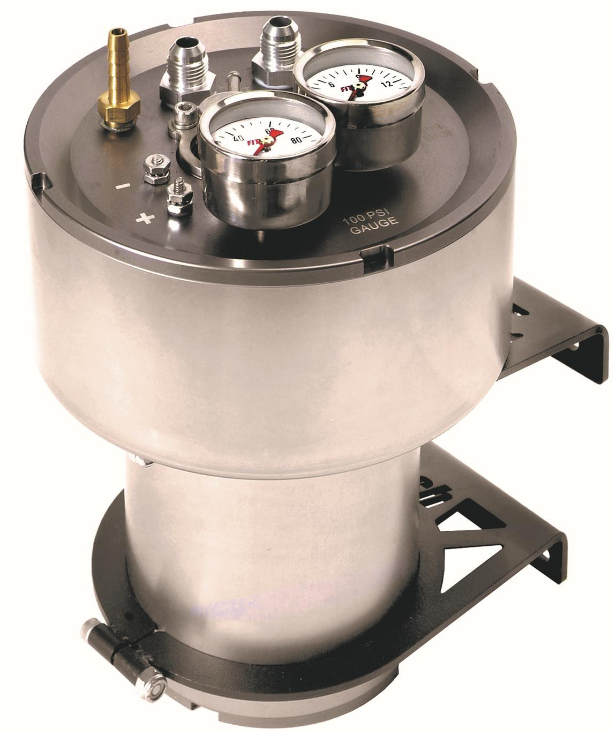
Content
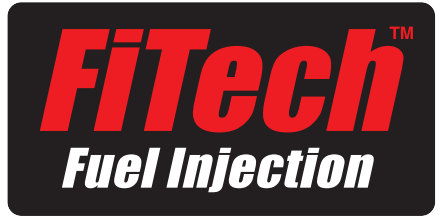
Introduction
The FiTech Fuel Injection Fuel Command Center 40003 is a fuel management solution designed to enhance the performance of vehicles by converting traditional carbureted systems to electronic fuel injection (EFI). Launched in December 2015, this product is manufactured by FiTech and is priced around $395. It facilitates better fuel delivery and efficiency, making it a popular choice for automotive enthusiasts looking to upgrade their engines for improved performance and reliability.
The Fuel Command Center is designed to be used only with FiTech EFI Systems that include the Pulse Width Modulation (PWM) feature.
The FiTech Fuel Command Center is the ultimate in a fuel delivery system. It not only is the most efficient way to supply fuel to your FiTech EFI system, it also greatly simplifies the installation process. It is a returnless system which effectively eliminates the need for a return line. It uses your stock fuel tank, stock carbureted fuel pump, and stock inlet fuel line. You simply disconnect the fuel line that runs from your pump to your carbure-tor and replace it from the pump to the Fuel Command Center which can be mounted in the en-gine compartment.
The only additional plumbing required is to run a line from the Fuel Command Center to the inlet port on the FiTech Go System EFI. Most necessary hose, hose ends, and fittings are supplied.
The Fuel Command Center contains an internal float mechanism that shuts off the fuel flow once the sump tank is filled. A 340 L/PH high pressure fuel pump is submerged in the fuel in the sump tank. A submerged pump runs quieter and cooler and lasts longer than external fuel pumps.
The Fuel Command Center is capable of providing enough fuel for engines producing up to 800 HP but is still suitable to be used on engines making as little as 200 HP.
NOTE: It is very important that a carbureted fuel pump is used to feed the Fuel Command Center. (8 PSI maximum).
40003 Kit Contents
- (1) Sump Tank Assembly
- (1) 340 L/PH Fuel Pump
- (1) 30 Micron Inline Fuel Filter 5' of EFI -06 Fuel Hose (Push Lock)
- (2) -06 AN 90° Hose Ends (Push Lock)
- (3) -06 AN Straight Hose Ends (Push Lock)
- (1) -06 AN 45° Hose End (Push Lock)
- (4) 5/16-18 x 1" Hex Head Bolts
- (4) 5/16 Flat Washers
- (4) 5/16-18 Lock Nuts
- (1) 0-15 PSI Fuel Pressure Gauge
- (1) 0-100 PSI Fuel Pressure Gauge
- (1) Hose Clamp

Specifications
- Advanced fuel management system with real-time monitoring
- Compatible with various fuel injection systems
- User-friendly interface for easy configuration and tuning
- Supports multiple fuel types and octane levels
- Includes features like idle air control, wide-band O2 sensor input, and adjustable fuel trim
- Durable construction with high-quality components
- Easy installation with comprehensive instructions
Description
The Fitech Fuel Injection Fuel Command Center 40003 is a comprehensive fuel management solution that integrates advanced technology to optimize engine performance. It features a robust design and user-friendly interface, making it accessible to both novice and experienced users. The system includes various adjustable parameters such as idle air control, fuel trim, and support for wide-band O2 sensors, allowing for precise tuning of the fuel system.
The Fuel Command Center 40003 also supports multiple fuel types and octane levels, ensuring compatibility with a wide range of vehicles and fuel sources. Its durable construction ensures long-term reliability and performance.
Installing the Fuel Command Center
Locate a suitable spot to install the Fuel Command Center. It can be mounted on the firewall, inner fender panel, or down on the frame if you have room. Five feet of fuel hose is supplied with this kit so the Center needs to be within five feet of the throttle body. Make sure you choose a position where the fuel hose can be routed without getting too close to the exhaust manifolds or any moving parts.
The supplied inline filter will be installed in the fuel line that runs from the Command Center to the EFI throttle body, so plan the routing of that line so there is a place to conveniently install the filter.
You must also install a conventional carburetor style (low pressure) filter between the fuel pump and the Fuel Com-mand Center to avoid dirt particles clogging the needle and seat inside the Command Center. The Command Center must be installed in the upright position. This is important for proper operation.
Using the two mounting brackets that secure the Com-mand Center in place as templates, mark spots to drill four holes. Drill four 11/32" diameter holes and secure the Com-mand Center in place with the supplied bolts, nuts and washers. If your mounting surface is not flat, use washers or spacers when mounting the Command Center so that it is in the vertical position.
Determine your necessary hose lengths. You will need three hose lengths. One will run from the stock fuel pump to the Command Center with a user-supplied filter.. A sec-ond will run from the Command Center to the Filter and the third runs from the Filter to the fuel injection Throttle Body. Cut the ends of the hose with a very sharp blade and make sure the end cut is square and clean. To install the hose ends, clamp the hose end in a vise using something to pro-tect the finish. Do not overtighten the vise and damage the hose end. Coat the hose end and hose liberally with WD-40 or some other lubricant. Push the hose onto the hose end making sure it fully bottoms out. Do not mix the sup-plied hose or hose ends with any other brand of hose or hose ends.
Your Command Center Kit includes several styles of push lock style hose ends. We recommend the following configuration of these hose ends. You may find that your particular installation may require a different configuration. If you need additional hose or hose ends you can order them direct from FiTech.
Hose and Hose Ends Usage
The hose that goes from the Command Center to the Fuel Filter should have a 90° hose end on the Command Center end and a straight hose end on the filter end. The hose that runs from the Filter to the throttle body should have a straight hose end on the filter end and a 45° hose end on the throttle body end.
The hose that goes from the stock fuel pump to the Command Center should have a straight hose end on the fuel pump end and a 90° on the end that feeds the Com-mand Center. This is just a suggested starting point. Care-fully plan your plumbing and fitting requirements. The FiTech throttle body has three inlet ports so pick the one that best suits your layout. Also remove the supplied return fitting and plug the return port on the throttle body with the supplied port plug. See Figure 4 on last page of these in-structions.
Command Center Vent Port
IMPORTANT
The Vent Port is a critical part of the installation and these instructions must be followed for a safe and proper operation of the system. The Command Center has a Vent Port complete with a Rollover Valve. A fuel rated hose or hard line must be routed from the Vent Port back to the fuel tank. Many vehicles are already equipped with a vent line to the tank. You can tee into the existing line if your vehicle is so equipped.
DO NOT run a vent line from the Command Center to the OPEN AIR in the engine compartment or pointed to the ground or to the air cleaner. Fumes from the Vent Port are dangerous and must be properly routed. You may need to change the pipe fitting on the Command Cen-ter to suit the line diameter you use. If no existing vent line to the tank exists, you must plumb your new line to a point above the fuel level of the tank at the top or in the filler neck. Proper routing of a vent line is not an option. It is a mandatory part of the installation.
If the vent is not prop-erly routed to the gas tank FiTech cannot be responsible for any fires or other issues resulting from improper vent rout-ing or failure to follow these instructions.
Determining Inlet Port On Throttle Body
- The Fuel Command Center is a returnless system.
- On your FiTech Go EFI System throttle body there are four fuel ports. (See figure 4) One is marked "Return." Plug that port with one of the plugs that came with the EFI kit.
Select any one of the remaining three ports as your inlet port. Install one of the supplied -06 AN fittings in the port that you have selected to use and install the supplied plugs in the other two ports.
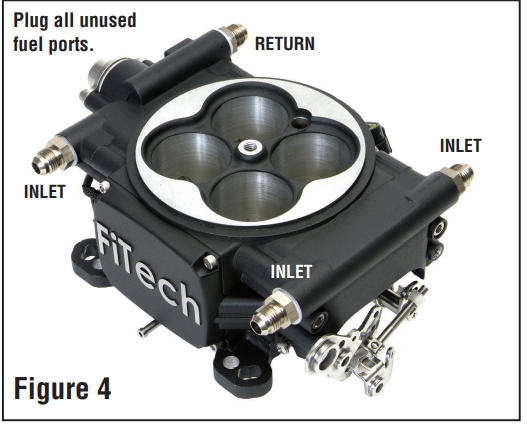
You will have one -06 AN fitting left over. (This fitting is required when using the 40005 Fuel Delivery Kit which is a return style system.)
Grounding the Command Center
- Run a ground wire from the negative (-) terminal on the Command Center to a metal grounded part of the car.
- If your battery is close to the Command Center you can attach the wire directly to the battery ground cable.
- Without a good ground the pump will not run.
- A self tapping metal screw may be needed to attach the wire end to a sheet metal part of the car. Make sure any paint is removed so the ground wire makes contact with bare metal.
Wiring the Command Center
Your FiTech EFI system has a large orange wire that is part of the group of wires from the ECU. This wire has to be connected to the positive (+) terminal on the Com-mand Center. Do not connect this wire to Command Cen-ter after the proper length has been determined. The system must be primed before this wire is connected oth-erwise you risk damaging the pump. Place some tape over the exposed end of the wire to avoid accidental con-tact with a metal surface.
Plumbing the Stock Fuel Pump to the Command Center Some stock pumps have a steel tube as the pump outlet. If your pump is so configured you can slip one end of the supplied -06 hose over the tube and secure it with a hose clamp. Other style pumps have a threaded port for the outlet. If the port has a fitting that has a barbed end where a stock fuel hose is clamped to it, you can use that fitting. If your pump has a hard line coming from the outlet port of the pump, remove the threaded fitting and replace it with a steel adapter fitting. There are two fuel pump adapter fittings available. They both provide a male -06 AN thread that you can connect a fuel hose to with one of the supplied -06 hose ends. The fitting with 1/2-20 threads fits Ford, Chrysler and pre-1970 Chevys. The fit-ting with 5/8-18 threads fits 1970 and later Chevys. Edel-brock pumps may require a special adapter fitting (available from Russell Performance).
If your pump has an outlet port with 3/8-NPT or 1/2-NPT ports you will need to acquire an adapter fitting with those threads on one end and -06 AN threads on the other. Adapter fittings are available from any fitting sup-plier such as Russell, Earl's or Aeroquip.
Plumbing the Command Center to the Throttle Body You have previously determined the lengths required for the hoses from the Command Center to the Fuel Filter and from the Filter to the Throttle Body. Install those hoses.
The supplied fuel filter is light enough that it's weight can be supported by the fuel hose. However, you can se-cure it with an Adel clamp or a tie wrap if desired. (Clamp or tie wraps are not included in this kit.)
Fuel Pressure Regulator
The Command Center has a built-in fuel pressure regu-lator mounted on the top.
This regulator is not adjustable but is pre-set to provide 58 PSI of fuel pressure to the EFI system.
The regulator has a vacuum nipple on it. When the Command Center is used with a Fitech Go EFI System, this nipple is left open unless you are using the Command Center on an engine with a blow through supercharger or turbocharger. In that case a vacuum hose should be run from the regulator to non-ported vacuum nipple on the throttle body. See Figure 2.
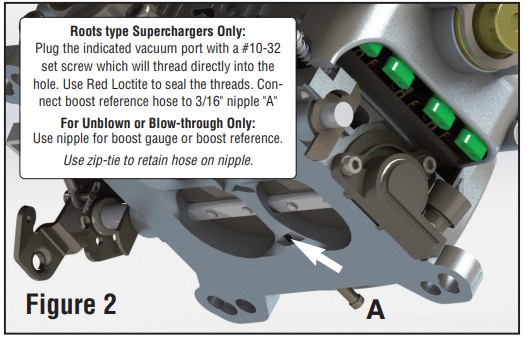
The Command Center can be used with any fuel in-jection system. Depending upon the design of the unit being used, different connections need to be made to the vacuum nipple on the regulator. If the throttle body in the system you are using has the injectors under the throttle plates, you need to connect a vacuum hose to a ported nipple on the throttle body. If the injectors are above the throttle plates, leave the nipple open. On a port injection system where the injectors are in the manifold, connect a vacuum line to a ported nipple on the throttle body.
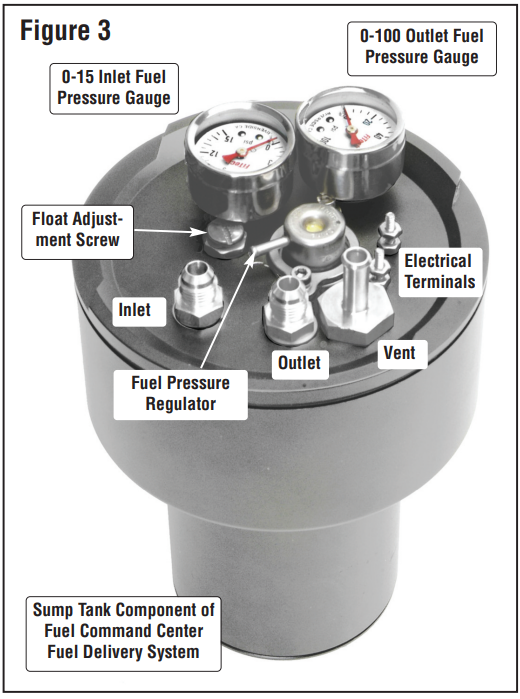
On an engine with a Roots supercharger a vacuum connec-tion should be made between the regulator and the throt-tle body if the injectors are under the throttle blades. If the injectors are above the throttle blades (which includes FiTech EFI systems) then leave the nipple port on the reg-ulator open.
Note that 43.5 PSI (3 BAR) regulators are available from FiTech when the Fuel Command Center is used with other aftermarket EFI systems that require this type of regulator.
Fuel Pressure Gauges on Sump Tank
The inlet gauge will show you the fuel pressure coming from your stock fuel pump. Do not use a pump that puts out more than 8 PSI. If your input reading is more than 8 PSI you will need to install a fuel pressure regulator be-tween the fuel pump and the Command Center. The outlet gauge will show you the fuel pressure being supplied to the EFI which will be in the 58 PSI range.
Priming the Command Center
Reconnect the negative battery cable. Do not connect the Fuel Command Center orange wire at this time. This is to avoid having the engine start during the priming proce-dure. Turn ignition key to the "ON" position and crank for ten seconds. Turn key to the "OFF" position and wait 30 seconds. Repeat this procedure a second time to fill the sump tank. This procedure allows your stock fuel pump to pump fuel to the Command Center but the Command Center is not pumping fuel to the EFI throttle body.
Check entire fuel system for any leaks before attempt-ing to start the engine.
- Be sure to install a carburetor style fuel filter between the stock fuel pump and the Fuel Command Center.
- Do not conect orange wire until Command Center has been primed.
CAUTION - Live wire. - Check all connections for leaks.
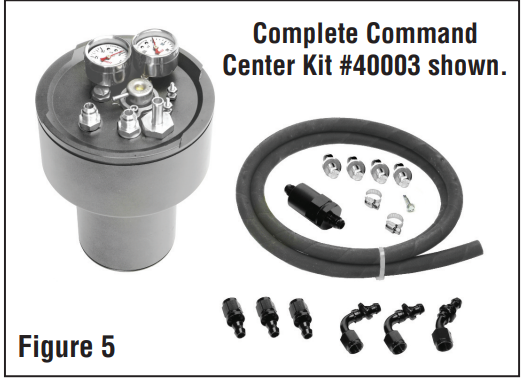
IMPORTANT NOTE: The fuel tank on your ve-hicle must be vented to avoid pressure build-ing up inside the tank. Do not attempt to install and operate an EFI system without a properly vented fuel tank.
Setup Guide
To set up the Fitech Fuel Injection Fuel Command Center 40003,
- Start by carefully reading the installation manual provided.
- Begin with mounting the unit in a secure location within your vehicle's engine compartment.
- Connect the necessary wiring and sensors according to the instructions, ensuring all connections are secure and free from any obstructions.
- Once installed, power on the unit and follow the on-screen prompts to configure the system.
- This includes setting up basic parameters such as engine type, fuel type, and idle settings.
- Use the provided software or the unit's interface to fine-tune the settings based on your vehicle's specific needs.
Troubleshooting
If you encounter issues with the Fitech Fuel Injection Fuel Command Center 40003,
- First, check all connections to ensure they are secure and properly connected.
- Common problems include incorrect wiring, faulty sensors, or misconfigured settings.
- For issues related to performance, refer to the troubleshooting section in the manual or contact Fitech support for assistance.
- Always follow safety instructions when working with electrical and fuel systems to avoid any potential hazards.
Fitech Fuel Injection Fuel Command Center 40003 Pros & Cons
Pros
- Advanced fuel management capabilities
- User-friendly interface for easy tuning
- Compatible with multiple fuel types and octane levels
- Durable construction for long-term reliability
- Comprehensive setup and troubleshooting guides
Cons
- Higher cost compared to basic fuel injection systems
- Requires technical knowledge for optimal tuning
- May require additional components or services for full functionality
Customer Reviews
Customers have generally praised the Fitech Fuel Injection Fuel Command Center 40003 for its advanced features and ease of use. Many have reported significant improvements in engine performance and fuel efficiency. However, some users have noted that the system can be complex to set up and tune, especially for those without prior experience with fuel injection systems.
Common complaints
Include the higher cost and the need for additional components or services to achieve full functionality.
Faqs
What is the primary purpose of the Fitech Fuel Injection?
Is the Fitech Injection compatible with all types of vehicles?
How difficult is it to install the Fitech Fuel Command Center?
Can I use the Fitech Fuel with different fuel types?
What are some common issues encountered with the Injection Fuel Command?
Does the Fitech Center 40003 come with a user-friendly interface?
What kind of support does Fitech offer for the 40003?
Can I install the Fitech Command Center 40003 myself?
What are the benefits of using the Fitech Fuel Injection?
Leave a Comment
